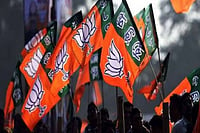Despite heightened global trade tensions and geopolitical instability, the Indian economy remains resilient and continues to expand steadily, according to the Reserve Bank of India's (RBI) June 2025 bulletin.
An article titled ‘State of the Economy’, authored by RBI officials, highlights that high-frequency indicators for May 2025 point to robust activity across both industrial and services sectors. The bulletin notes that e-way bills, Goods and Services Tax (GST) collections, toll receipts, and digital payments all registered solid growth during the month.
According to provisional estimates released by the National Statistical Office (NSO), India’s real GDP growth for FY 2024-25 stands at 6.5%, in line with the Second Advance Estimates (SAE). The expansion has been largely driven by two main components: private final consumption expenditure (PFCE) and gross fixed capital formation (GFCF), contributing 4 and 2.4 percentage points respectively to overall growth.
The Indian economy saw a sharp uptick in growth in the final quarter of FY25, registering 7.4% GDP growth—a full percentage point higher than the 6.4% recorded in the previous quarter. This acceleration was primarily driven by a strong increase in fixed investment, which rose to 9.4% in Q4, up from 5.2%, supported by ongoing momentum in construction activity.
Notably, the contribution of net exports to GDP reached its highest level since Q2 FY21, reflecting improved trade performance despite a challenging global environment.
The article presents a mixed picture of demand. While urban consumption showed signs of softening—evidenced by a drop in passenger vehicle sales, particularly in the entry-level segment—rural demand strengthened, as indicated by a rise in two-wheeler sales.
GST revenues crossed the Rs 2 lakh crore mark for the second consecutive month in May, buoyed by strong import-related GST collections. Meanwhile, headline inflation, measured by year-on-year changes in the Consumer Price Index (CPI), eased to 2.8% in May 2025—its lowest level since February 2019 and below the RBI’s target for the fourth straight month.
“The domestic price situation remains benign,” the article stated, adding that financial conditions were supportive, allowing for the smooth transmission of recent interest rate cuts to the credit market.
The article also flagged encouraging signs on the investment front. Foreign direct investment (FDI) inflows stood at $3.9 billion in April 2025, more than double the inflows recorded in April 2024. Between 2020 and 2024, India attracted $114 billion in greenfield investments in digital sectors, ranking highest among countries in the Global South and placing 16th globally in total FDI inflows.
The RBI clarified that the views expressed in the article are those of the authors and do not represent the official stance of the central bank. Nonetheless, the data underlines India’s continuing economic resilience, even amid an increasingly volatile global landscape.



























